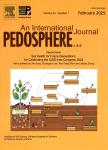Inoculation with Phosphate-Solubilizing Fungi Diversifies the Bacterial Community in Rhizospheres of Maize and Soybean
Inoculation with Phosphate-Solubilizing Fungi Diversifies the Bacterial Community in Rhizospheres of Maize and Soybean作者机构:Laboratory of Black Soil Ecology Northeast Institute of Geography and Agroecology Chinese Academy of Sciences Harbin 150081 (China). Department of Agricultural Sciences La Trobe University Bundoora Vic 3086 (Australia)
出 版 物:《Pedosphere》 (土壤圈(英文版))
年 卷 期:2007年第17卷第2期
页 面:191-199页
核心收录:
学科分类:090101[农学-作物栽培学与耕作学] 09[农学] 0901[农学-作物学]
基 金:Project supported by the Director Fund of Northeast Institute of Geography and Agroecology, Chinese Academy of Sciences the National High Technology Research and Development Program (863 Program) of China (No. 2006AA10Z424)
主 题:bacterial community diversity PCR-DGGE phosphate-solubilizing fungus rhizosphere
摘 要:Application of phosphate-solubilizing microorganisms (PSMs) has been reported to increase P uptake and plant growth. However, no information is available regarding the ecological consequences of the inoculation with PSMs. The effect of inoculation with phosphate-solubilizing fungal (PSF) isolates Aspergillus niger P39 and Penicillium oxalicum P66 on the bacterial communities in the rhizospheres of maize (Zea mays L. Haiyu 6 ) and soybean (Glycine max Merr. Heinong 35 ) was examined using culture-dependent methods as well as a culture-independent method, polymerase chain reaction-denaturing gradient gel electrophoresis (PCR-DGGE). Compared with the control, the number of culturable microbes for soybean was significantly greater with P39, whereas for maize, the same was significantly greater with P66. In addition, a greater number of microbes were found in the rhizosphere of maize compared with soybean. The fingerprint of DGGE for 16S rDNA indicated that inoculation with PSF also increased bacterial communities, with the P66 treatment having higher numbers of DGGE bands and a higher Shannon-Weaver diversity index compared with P39; the composition of the microbial community was also more complex with the P66 treatment. Overall, complex interactions between plant species and exotic PSMs affected the structure of the bacterial community in the rhizosphere, but plant species were more important in determining the bacterial community structure than the introduction of exotic microorganisms.




